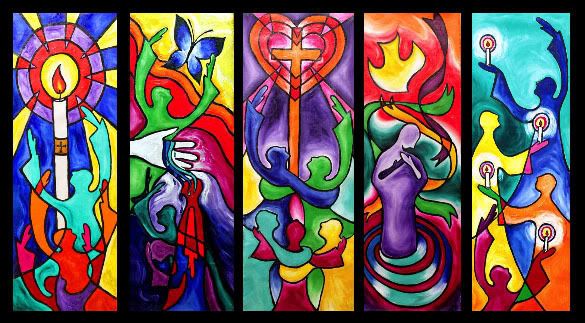by Pastor Laura Gentry
Today, we celebrate Trinity Sunday—the only day of the church year dedicated to a theological teaching of the church not associated with the life of Jesus and given the name “Trinity,” which is not even in the bible. Now why in the world is such a ancient and difficult-to-understand festival sandwiched right into our church year?
It all began in the ninth century where Christians in French monastic communities would celebrate the festival of the Holy Trinity. They were carrying on the tradition of the early Christians, who developed the teaching of the Trinity in order to give them a common understanding of God , which helped Christians understand that God was one, not three gods. Later, in the fourteenth century, the festival became so widespread that it was added to the church calendar and has been celebrated throughout the world ever since.
So now let us look at the three persons of God to help us understand and celebrate the Holy Trinity.
FATHER
God as God the Father—the Creator of our entire universe. In this morning’s lessons, we heard from the Genesis story of creation in which God calls the universe into being by the power of God’s word. God the Father is the all-powerful, eternal, yet loving source of all life. All that we are and all that we have come from God the Father. In the explanation of the Apostle’s Creed, Martin Luther said we ought to thank, praise, serve and obey the Father. And added his signature ending: this is most certainly true.
SON
God the Son in the form of Jesus. What does it mean that God became flesh and dwelt among us? We ponder this each year at Christmas time.
Soren Kierkegaard, the great Danish theologian, tells a story of a prince who wanted to find a maiden suitable to be his queen. One day while running an errand in the local village for his father he passed through a poor section. As he glanced out the windows of the carriage his eyes fell upon a beautiful peasant maiden. During the ensuing days he often passed by the young lady and soon fell in love. But he had a problem. How would he seek her hand?
He could order her to marry him. But even a prince wants his bride to marry him freely and voluntarily and not through coercion. He could put on his most splendid uniform and drive up to her front door in a carriage drawn by six horses. But if he did this he would never be certain that the maiden loved him or was simply overwhelmed with all of the splendor. As you might have guessed, the prince came up with another solution. He would give up his kingly robe. He moved, into the village, entering not with a crown but in the garb of a peasant. He lived among the people, shared their interests and concerns, and talked their language. In time the maiden grew to love him for who he was and because he had first loved her.
This very simple, written by one of the most brilliant minds of our time explains what we Christians mean by the incarnation. God came and lived among us. I am glad that this happened for two reasons. One, it shows beyond a shadow of a doubt that God is with us, that God is on our side, and that God loves us. Secondly, it gives us a first hand view of what the mind of God is really all about. When people ask what God is like, we as Christians point to the person of Jesus Christ. God himself is incomprehensible. But in Jesus Christ we get a glimpse of his glory. In the person of Jesus we are told that God, that mysterious other that created the stars and the universe—who didn’t even need to bother to be mindful of us—is willing to go all of the way, to become one of us: talk our language, eat our food, share our suffering and die on a cross. Why? So that a single person, you, me, might be redeemed. And, grow to love the infinite God who created you.
HOLY SPIRIT
And we know God as the Holy Spirit —the one who is with us in this very moment, inspiring us, illuminating the Scriptures, animating our faith and worship, interceding for us in our weakness "with sighs too deep for words," leading us, strengthening us, turning on the lights for us when our paths become unclear. Just last week, we celebrated the Sunday of Pentecost, in which we talked about how the Holy Spirit came to the disciples and has been blowing through the church ever since, blowing as powerfully as the wind. Jesus told us that this Spirit blows where it pleases. That is something we ought to be excited about.
TRINITY
Saint Augustine often puzzled about the whole idea of describing God as a Trinity. He described an incident in which he was walking along the beach and observed a young boy with a bucket, running back and forth to pour water into a little hole. Augustine asked, "What are you doing?" The boy replied, "I'm trying to put the ocean into this hole." It suddenly occurred to Augustine that just as this boy was pursuing the ridiculous goal of putting the whole ocean into the hole, he was pursuing an equally ridiculous goal: trying to put an infinite God into his finite mind. We, with our very limited brains (in comparison to God’s wisdom), have come up with the doctrine of the Holy Trinity—the belief that God is expressed in three parts as Father, Son and Holy Spirit. But we must recognize, as Augustine did, that we could never fully understand God—we could never capture God’s entire essence with a doctrine. But this doctrine can be helpful in getting us to know our three-personed God.
Garrison Keillor once said of love, “We should not think that we have figured this out, because it is not a problem, it’s a mystery and always will be.” The same could be said of the doctrine of the Trinity. We don’t have to think of it as a problem to be solved, but rather a glorious mystery in which to relish.
But what does it mean for us that God is three, yet one? The Athanasian Creed states “And in this Trinity, no one is before or after, greater or less than the other; but all three persons are in themselves, coeternal and coequal; and so we must worship the trinity in unity and the one God in three persons.” These three, equal persons of God work together in community as one, unified God. Some theologians insist that what is most important about belief in a triune God is not that we see God in three ways, but that we understand God as dynamic community. God, you see, is a like a committee that actually works.
What is unique about Trinitarian theology, is that it explains that there is an inner relational energy within the three forms of God. John of Damascus, an eighth-century theologian, described the Trinity with the Greek word "perichoresis." This word comes from the same root as the word "choreography." It suggests that there is a movement, a harmonious dance within the internal life of God.
So if God is a community and we are created it God’s image, what does that mean? It means that we are created to be in relationship, just as God is in relationship. The doctrine of the Trinity gives us a vision of a community of women and men in church and society who treat each other as equals and work together in shared responsibility of unity and love. You see, when we understand God in terms of the doctrine of the Trinity, we can see within the very person of God, a radical example of a community built on justice, relationship and care.
So that is what we are celebrating today. In clear terms, the profound mystery of the Trinity tell us who God is: the Creator, the Redeemer, and the Spirit who exist in perfect community with one another. And as people formed in God’s image, it tells us who we are, and why we crave community. May our hearts follow this natural impulse to search and out and find connections with God and with one another that we may be one as God is one.
It all began in the ninth century where Christians in French monastic communities would celebrate the festival of the Holy Trinity. They were carrying on the tradition of the early Christians, who developed the teaching of the Trinity in order to give them a common understanding of God , which helped Christians understand that God was one, not three gods. Later, in the fourteenth century, the festival became so widespread that it was added to the church calendar and has been celebrated throughout the world ever since.
So now let us look at the three persons of God to help us understand and celebrate the Holy Trinity.
FATHER
God as God the Father—the Creator of our entire universe. In this morning’s lessons, we heard from the Genesis story of creation in which God calls the universe into being by the power of God’s word. God the Father is the all-powerful, eternal, yet loving source of all life. All that we are and all that we have come from God the Father. In the explanation of the Apostle’s Creed, Martin Luther said we ought to thank, praise, serve and obey the Father. And added his signature ending: this is most certainly true.
SON
God the Son in the form of Jesus. What does it mean that God became flesh and dwelt among us? We ponder this each year at Christmas time.
Soren Kierkegaard, the great Danish theologian, tells a story of a prince who wanted to find a maiden suitable to be his queen. One day while running an errand in the local village for his father he passed through a poor section. As he glanced out the windows of the carriage his eyes fell upon a beautiful peasant maiden. During the ensuing days he often passed by the young lady and soon fell in love. But he had a problem. How would he seek her hand?
He could order her to marry him. But even a prince wants his bride to marry him freely and voluntarily and not through coercion. He could put on his most splendid uniform and drive up to her front door in a carriage drawn by six horses. But if he did this he would never be certain that the maiden loved him or was simply overwhelmed with all of the splendor. As you might have guessed, the prince came up with another solution. He would give up his kingly robe. He moved, into the village, entering not with a crown but in the garb of a peasant. He lived among the people, shared their interests and concerns, and talked their language. In time the maiden grew to love him for who he was and because he had first loved her.
This very simple, written by one of the most brilliant minds of our time explains what we Christians mean by the incarnation. God came and lived among us. I am glad that this happened for two reasons. One, it shows beyond a shadow of a doubt that God is with us, that God is on our side, and that God loves us. Secondly, it gives us a first hand view of what the mind of God is really all about. When people ask what God is like, we as Christians point to the person of Jesus Christ. God himself is incomprehensible. But in Jesus Christ we get a glimpse of his glory. In the person of Jesus we are told that God, that mysterious other that created the stars and the universe—who didn’t even need to bother to be mindful of us—is willing to go all of the way, to become one of us: talk our language, eat our food, share our suffering and die on a cross. Why? So that a single person, you, me, might be redeemed. And, grow to love the infinite God who created you.
HOLY SPIRIT
And we know God as the Holy Spirit —the one who is with us in this very moment, inspiring us, illuminating the Scriptures, animating our faith and worship, interceding for us in our weakness "with sighs too deep for words," leading us, strengthening us, turning on the lights for us when our paths become unclear. Just last week, we celebrated the Sunday of Pentecost, in which we talked about how the Holy Spirit came to the disciples and has been blowing through the church ever since, blowing as powerfully as the wind. Jesus told us that this Spirit blows where it pleases. That is something we ought to be excited about.
TRINITY
Saint Augustine often puzzled about the whole idea of describing God as a Trinity. He described an incident in which he was walking along the beach and observed a young boy with a bucket, running back and forth to pour water into a little hole. Augustine asked, "What are you doing?" The boy replied, "I'm trying to put the ocean into this hole." It suddenly occurred to Augustine that just as this boy was pursuing the ridiculous goal of putting the whole ocean into the hole, he was pursuing an equally ridiculous goal: trying to put an infinite God into his finite mind. We, with our very limited brains (in comparison to God’s wisdom), have come up with the doctrine of the Holy Trinity—the belief that God is expressed in three parts as Father, Son and Holy Spirit. But we must recognize, as Augustine did, that we could never fully understand God—we could never capture God’s entire essence with a doctrine. But this doctrine can be helpful in getting us to know our three-personed God.
Garrison Keillor once said of love, “We should not think that we have figured this out, because it is not a problem, it’s a mystery and always will be.” The same could be said of the doctrine of the Trinity. We don’t have to think of it as a problem to be solved, but rather a glorious mystery in which to relish.
But what does it mean for us that God is three, yet one? The Athanasian Creed states “And in this Trinity, no one is before or after, greater or less than the other; but all three persons are in themselves, coeternal and coequal; and so we must worship the trinity in unity and the one God in three persons.” These three, equal persons of God work together in community as one, unified God. Some theologians insist that what is most important about belief in a triune God is not that we see God in three ways, but that we understand God as dynamic community. God, you see, is a like a committee that actually works.
What is unique about Trinitarian theology, is that it explains that there is an inner relational energy within the three forms of God. John of Damascus, an eighth-century theologian, described the Trinity with the Greek word "perichoresis." This word comes from the same root as the word "choreography." It suggests that there is a movement, a harmonious dance within the internal life of God.
So if God is a community and we are created it God’s image, what does that mean? It means that we are created to be in relationship, just as God is in relationship. The doctrine of the Trinity gives us a vision of a community of women and men in church and society who treat each other as equals and work together in shared responsibility of unity and love. You see, when we understand God in terms of the doctrine of the Trinity, we can see within the very person of God, a radical example of a community built on justice, relationship and care.
So that is what we are celebrating today. In clear terms, the profound mystery of the Trinity tell us who God is: the Creator, the Redeemer, and the Spirit who exist in perfect community with one another. And as people formed in God’s image, it tells us who we are, and why we crave community. May our hearts follow this natural impulse to search and out and find connections with God and with one another that we may be one as God is one.
© 2009 Laura Gentry








No comments:
Post a Comment